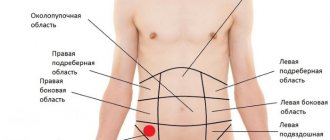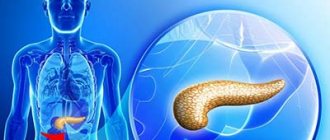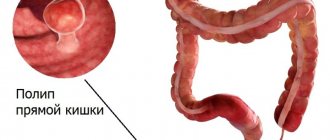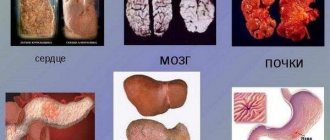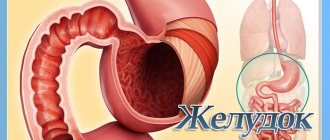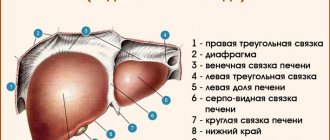The liver (hepar) is the largest parenchymal organ in the human body. It accounts for 1/50 of the weight of an adult and 1/20 of a newborn. Performs many functions, including taking part in the processes of digestion, detoxification, and hematopoiesis. Weight: 1300–1800 grams. Consists of two lobes separated by the falciform ligament. Adjacent directly to the diaphragm. Blood supply is carried out through the system of hepatic arteries and vena portae hepatic. Outflow is through the heptral veins.
Signs of liver disease: bitterness in the mouth, pain in the right hypochondrium, spider veins on the body. A significant decrease in the functional capacity of an organ leads to the formation of acute failure with disruption of many vital processes. This becomes possible only with prolonged exposure to the pathogenetic factor, since the liver has an excellent ability to regenerate.
Causes of disease and location of the human liver, photo
The condition of the liver is influenced by a person’s lifestyle , bad habits, nutrition and environment. If we cannot change the environment, then every person can monitor their diet. In the human body, the liver is located under the ribs in the upper right part of the abdomen, approximately below the level of the nipples:
It is important to follow simple rules such as eliminating or minimizing the amount of fried and fatty foods, avoiding high-calorie foods, and drinking enough water. It is also very important to follow a diet. Meals should not be plentiful, it is better to eat after 2-3 hours, but in small portions. This will amount to 5-6 meals a day, three of which should be main meals, and two or three snacks that prevent hunger.
Drinking alcohol, including beer, smoking, a sedentary lifestyle, eating at night, and overeating have a very strong impact on the liver. All this leads to increased load on the liver. Its main function is to cleanse toxins and harmful substances, regulate blood supply and participate in metabolic processes. Under normal conditions, the liver is able to repair itself and there are no malfunctions in its functioning. But when the above mentioned harmful factors are present, it can no longer cope with so many harmful substances and its functions, it begins to intensively produce new cells to enhance its capabilities, therefore, it increases in size, which is a signal to take urgent measures for restoration and treatment liver.
The photo will best show where the human liver is located. It is located in the abdominal cavity on the right side. Its lower part is located under the ribs, and the upper part is under the diaphragm itself at the level of the nipples. It would be more correct to say that on the right side there is a larger part of it, and the smaller left side is already closer to the spleen and pancreas, which are located on the left side of the peritoneum.
Since the liver is involved in metabolic processes and cleansing the body, hematopoiesis, it is connected with many organs of the gastrointestinal tract. As mentioned above, this is the largest human organ, therefore it is vital, that is, a person cannot live without a liver. It is very important to protect it from impacts and injuries that lead to ruptures and injuries to the liver, and to protect it from harmful effects as a result of an unhealthy lifestyle and bad habits.
In addition to all of the above, it is also possible to become infected with parasites that settle both in the liver itself and in the vessels and bloodstreams located in it . Very closely connected to the liver is the gallbladder, which stores the bile produced by the liver. Often it signals liver dysfunction. In any case, you need to listen to your body, periodically undergo examination by a doctor and take the necessary tests in order to promptly identify the disease and help the body cope with it.
Where is the liver located
In humans, the liver is located in the right zone of the abdominal cavity .
A small part of it extends to the left of the midline. The organ is completely covered by the ribs. The anterosuperior surface is adjacent to the diaphragm and is located at the level of the IV intercostal space. The left lobe reaches the V costal space. The lower part is in contact with the abdominal organs along the right nipple line. Normally, it does not go beyond the costa arc. Full palpation while maintaining anatomical parameters is impossible. It is possible to palpate the formation only when its size increases significantly, which occurs in some infectious diseases, poisoning, right ventricular failure, and oncological processes of the hepatobiliary system.
Liver, what kind of organ is it?
The liver is the largest digestive gland in animals and humans, which produces bile.
The liver performs a recycling, cleansing function. Removes toxic substances. The gland takes part in vitamin metabolism, as well as hematopoiesis. Pathologies of this organ can lead to disruption of functions important to life. The normal functioning of this organ directly depends on a person’s daily lifestyle.
Almost every person knows in which area of the abdomen this gland is located. On the right side, under the ribs (see photo above). In addition to the gland, other organs are located there, namely the digestive and respiratory systems. How to find out what is bothering the gland specifically?
Important point! The gland itself in the right hypochondrium does not hurt; its membrane or organs, pressure on which is exerted by the enlarged exocrine gland, are disturbing.
What functions are assigned to the organ?
And so, we have told you what is on the right side of any person, it’s time to talk about the functions of the liver.
The body performs
the following functions:
- Metabolic. This function is to control the exchange of fluid in the body, as well as vitamins, hormones, dietary supplements and other microelements.
- Depositing. Promotes the accumulation of useful components and elements in iron.
- Secretory. This function is responsible for the production of bile.
- Detoxification. As a result of this, all pathogenic microorganisms and substances are eliminated from the human body, which is facilitated by the liver filter - hepatic macrophages.
- Excretory. Glucuronic and sulfuric acids bind all kinds of toxins.
- Homeostatic. The endocrine gland takes an active part in the control of antigenic and metabolic hemostasis in the body.
This is interesting! How we are made: human structure - internal organs in detailed description and location diagram
Liver diseases: causes of pain
Abscess
A formation with purulent accumulations appears in the tissues of the gland. It appears due to cholecystitis and cholelithiasis. The location of the formation can be determined by pain in one area or another. It is necessary to urgently consult a doctor, because if the formation breaks through, there will be serious consequences.
Hepatitis
Hepatitis is an inflammatory process. It can be viral, toxic or autoimmune. It can be determined by the enlarged size of the liver. Due to changes in the structure of the liver, cirrhosis develops.
Cirrhosis
This disease has the potential to be fatal. The gland enlarges due to the proliferation of connective tissue in its structure. And also, the exocrine gland stops functioning. Liver cirrhosis is asymptomatic for a long time. But at the beginning of the development of the disease, minor changes in the person’s condition may appear: fatigue, lethargy, irritability.
Liver failure
With this pathology, the organ is almost unable to fulfill its role. This is fraught with consequences for the functioning of the entire organism.
In addition to these diseases, there are other causes of pain in the liver:
- pregnancy;
- hormonal drugs;
- steroids;
- eating fatty and fried foods;
- daily alcohol consumption.
Let's talk about alcohol separately.
Alcohol and liver (Alcoholic cirrhosis, Alcoholic hepatitis)
Every person knows that alcoholic drinks destroy liver cells, causing alcoholic cirrhosis and alcoholic hepatitis. Since men are exposed to bad habits more often than women, their risk of serious illness caused by alcohol is higher. However, alcoholism in the weaker sex develops many times faster than in men. Accordingly, diseases of the gland and other organs develop more intensively in women than in men. It is worth emphasizing that female alcoholism is incurable.
With the systematic consumption of alcoholic beverages, gland cells die and are replaced by connective tissue. An inflammatory process develops, in which the organ grows and puts pressure on neighboring organs, which causes pain. It will take a lot of time for the liver to recover and, most importantly, to forget about alcohol forever.
Treatment recommendations
Complex cases of liver failure (cirrhosis, viral hepatitis) are treated in a hospital with the help of a therapeutic diet, hepatoprotectors (Essentiale Forte), antiviral (Ribavirin) and hormonal drugs (Prednisolone).
If the disease is provoked by alcohol, then the person is prescribed hepatoprotectors with antioxidant action (Heptral), a healthy lifestyle and a vegetarian diet. In case of toxic poisoning of the body, cleansing droppers of saline solution with glucose are placed and Rezalut is prescribed.
Benign and malignant tumors are removed surgically. Pain caused by a bruise or prolonged physical activity is eliminated, providing the sick person with peace.
Symptoms of liver disease
The accompanying signals will help prove the fact that the pathology occurs specifically in the liver:
- fast fatiguability;
- weakness;
- lack of appetite;
- nausea;
- constant belching;
- enlarged belly on the right side;
- severe weight loss;
- yellowness of the skin
- discolored urine and stools;
- itching and dry skin;
- swelling.
Liver pathology is visible externally. The quality of hair, nail plates and epithelium deteriorates due to the fact that iron does not cope with complete cleansing; toxins and waste accumulate in the body. The epithelium on the face dries out and becomes dull, rashes form, hair falls out, and the nail plates break and peel.
The most important thing you need to know: if these symptoms appear, you must immediately consult a doctor; self-medication in this situation is strictly prohibited.
How to understand that it is the liver that hurts?
Speaking of liver diseases, the sensations suggest that it is the liver that has suffered some kind of disease. For example, sudden, intense pain in the right hypochondrium of a spastic nature may indicate hepatic colic.
| How does the liver hurt and what does this pain mean? | |
| Dull pain on the right under the ribs | It signals liver diseases such as hepatitis A, B; constant dull pain in the right hypochondrium may indicate the presence of hepatitis C. Such pain is also possible with an exacerbation of a chronic process in the liver or an increase in its size. Also, this symptom may indicate the presence of parasites in the liver or an abscess, which are accompanied by an additional feeling of fullness. |
| Aching pain in the intended area of organ location | He speaks, rather, of cholecystitis. Also, similar sensations may be present in the following liver diseases: hepatomegaly, hepatitis A, B, C, or developed liver abscess. |
| Throbbing pain on the right under the ribs | May indicate liver disease such as a cyst or parasitic liver disease. |
The following symptoms that occur in parallel can confirm that the pain felt comes from the liver:
- fast fatiguability;
- constant weakness;
- poor appetite;
- nausea that occurs regardless of meals;
- frequent belching;
- enlargement of the right side of the abdomen, stretching of the skin in this area;
- weight loss due to food refusal;
- a characteristic “bell” for diseases of the liver, gallbladder and bile ducts is jaundice (pronounced signs of which are yellowing of the skin, yellowness of the sclera of the eyes);
- change in the color of urine and feces;
- itching and dry skin;
- yellow coating on the tongue;
- swelling of the limbs and face.
Diagnostics
Using laboratory tests of diagnostic procedures, a qualified specialist can identify liver pathology in the early stages of disease development. The treatment system will be determined depending on what caused the pain after diagnostic measures.
Types of diagnostic procedures that a doctor will prescribe for patients with liver pain:
- Laparoscopy;
- Biopsy;
- Ultrasound;
- MRI;
- CT;
- General and biochemical blood test;
- Tests for viral hepatitis and cancer;
- Genetic research;
- Immunological tests.
Treatment is selected individually, based on the results of these tests.
Treatment
Most illnesses are treated in a hospital. And many diseases can be treated in simple ways. If this is alcoholic hepatosis, then you should forget about alcohol and choose a diet. In case of toxic poisoning, poisons are removed from the blood through detoxification. Other diseases can be cured by taking antibacterial and antiviral drugs. Surgeon intervention is necessary in the presence of cysts and tumor formations.
And if pain in the gland is due to injury or physical activity, then you should just rest. No treatment as such is required.
Pain relief medications (first aid for liver pain)
The following special drugs are used to help relieve spasm and severe pain in the liver:
- No-shpa
You can take tablets, but it is advisable to administer the medicine intramuscularly, because in this form the drug can relieve suffering in a shorter time than tablets. But we must also forget that No-spa is not used for liver failure.
- Papaverine
Its injections are also used to suppress pain. The direct purpose of the drug is to relax the smooth muscles of the digestive and genitourinary systems. But, again, the use of this drug for liver failure is prohibited.
This drug is administered in various ways.
- Analgin
You cannot take analgin yourself, because... it may mislead your doctor by dulling pain or changing signs of pathology. And also, Analgin additionally loads the exocrine gland.
However, the doctor may prescribe injections of this drug if he considers it necessary.
How to cleanse the liver with folk remedies
Although it was indicated that you cannot self-medicate for pain in the liver, it is still worth noting a couple of points about alternative medicine. You can try liver herbal teas, they are sold in pharmacies and do not require a prescription from a doctor.
For this purpose, we have written a separate article, and we advise you to read it: How to cleanse the liver at home quickly and effectively using folk remedies to remove toxins.
With all this, you should not abuse traditional medicine. Since inflammatory processes can lead to cirrhosis of the liver.
Diet for liver diseases
Let's start with the fact that it is necessary to eliminate bad habits (smoking and alcohol).
Products whose consumption should be minimized:
- Alcohol. Exceptions may include medications (tinctures, decoctions, etc.);
- Butter. You shouldn’t cut it out of your diet at all, because oil has a beneficial effect on some organs;
- Fast food. Absolutely forbidden. Fast food products contain a huge number of components hazardous to health;
- Pork lard, duck and goose meat are recommended to be consumed in small portions;
- Kiwi. You should also reduce your consumption of this fruit;
- Sweet and rich pastries;
- Hot spices and smoked meats.
To prevent liver diseases at home, you should not suddenly change your diet, because this can have a bad effect on the condition of the liver. All changes in diet must be made gradually.
You should drink no more than three liters of fluid per day. It is advised to eat boiled and steamed food. It is also recommended to consume food before 8 pm.
To prevent liver problems, you need to include a number of foods in your diet:
- Wholemeal breads and pastries;
- Vegetable soups with low-fat broth;
- Fresh vegetables and fruits;
- Dairy products with 0% fat content;
- Boiled and stewed fish;
- Freshly squeezed juices, not strong tea and coffee.
Proper nutrition is the key to a healthy liver.
Nutrition for liver diseases
If diseases of this organ are detected, the patient is prescribed a diet - table No. 5. This diet includes a complete abstinence from the following foods:
- Coffee, tea and alcoholic drinks.
- Tomato juice.
- Rich broths.
- Corn or millet porridge.
- Sweet carbonated drinks.
- Fatty meat (pork, duck) and fatty fish.
- Liver.
- Pasta with spicy sauces.
- Smoked meats.
- Sausages.
- Canned food and semi-finished products.
- Sweet fatty confectionery products.
- Fresh white bread.
- Milk.
- Conservation.
- Garlic.
- Mushrooms.
- Mayonnaise.
You can eat the following foods:
- Yesterday's bread with bran.
- Lean meat and fish.
- Stewed vegetables.
- Cottage cheese.
- Butter.
- Eggs.
- Pumpkin.
- Porridge (rice, buckwheat, oatmeal).
- Honey (in small quantities).
All dishes must be boiled or baked. They cannot be fried. Puddings, all kinds of casseroles, aspic, and puree soups are perfect for humans. It is also important that the dishes are not salty and contain a minimum of vinegar, sugar, and pepper.
Read more about the liver diet here.
pdoctor.ru
Videos on the topic
source: tvojajbolit.ru
To prevent a number of serious diseases, you need to clearly understand which organ is associated with certain pain sensations. But few people think about where exactly this or that organ is located. In this article we will talk about the largest of them - the liver.
Where is the liver located?
The largest organ found in a living body is the liver. It is located in the upper right corner of the peritoneum and is hidden by the costal arches. Where is the human liver located?
The human liver is located in the upper right corner of the peritoneum and is covered by the ribs . The apex of the right lobe is located in the middle of the fifth rib and extends slightly to the right.
The lower border runs perpendicular to the eighth and ninth left ribs. The lower edge is located below the costal arches and passes in the middle between the navel. Liver pain has different origins.
Ways to saturate the circulatory system
Blood supply occurs in two ways:
- Intestines . Blood supply via the portal vein.
- Spleen . Blood supply via the hepatic artery.
The hepatic artery and portal vein form branches that lead to the lobes of the liver. The liver is covered with serous tissue, so its surface is smooth and shiny. The rear surface is an exception; the surface of the inner side converges with the diaphragm . Also, the human liver consists of small lobes, the number of which can vary between 450,000–500,000 thousand.
The lobes of the animal liver differ from the similar human organ in that they are poorly limited from each other due to the small development of connective tissue. Liver pain has different origins . For example, they may be associated with painful conditions such as renal colic, cholecystitis, and various injuries.
It is imperative to know where a person’s liver is located, otherwise it will be difficult to determine the location of the pain.
Painful conditions
If liver function is disrupted for some reason, this can lead to irreparable consequences. Therefore, you should take your health seriously, since even the simplest ailment can be a signal of a serious illness.
The main symptom of a painful condition of the liver is the release of vomit, a yellowish color of the skin and cornea of the eye. Diarrhea, change in the color of urine, a feeling of bitterness in the mouth, accompanying signals of a painful state of the organ. Pain in the liver itself is often observed, which may indicate an increase in the volume of the organ . The pain increases with movement, has an aching sensation and can radiate to the back and right hypochondrium.
Secondary symptoms may include increased flatulence, nausea after eating fatty foods and complete loss of appetite. All these symptoms can be either complex or isolated, it all depends on the specific disease.
The most famous liver diseases
Hepatitis A . An infectious disease transmitted by eating contaminated food, water and through direct contact with a sick person. This type of hepatitis is very common in countries with poor sanitation conditions. Signs of the disease can be different, most often there is an increase in body temperature, general malaise, profuse vomiting, yellowing of the skin and cornea of the eyes. There is no special treatment; therapy is aimed only at maintaining the water balance of the body lost due to vomiting and diarrhea.
With this type of disease, gentle fractional nutrition with small portions . Fractional meals are aimed at stimulating appetite, which almost completely disappears during illness. A person’s diseased liver cannot cope with large amounts of food, so you need to eat small portions.
First of all, you should limit your salt intake, as it causes a delay in the removal of fluid from the body, resulting in swelling. It is worth noting that the temperature of food consumed should be 36–37 degrees in order to reduce the load on the diseased liver. Alcohol is completely excluded for the entire recovery period and for 6 months during rehabilitation. At this time, it is better to drink more rosehip decoction, various fruit drinks, and herbal infusions.
Hepatitis B . The most severe and common disease. Infection mainly occurs through exposure to contaminated blood. It can also be transmitted sexually and through the use of non-sterile syringes by drug addicts. The initial stage of hepatitis is similar to the symptoms of the flu; there is an increase in temperature, pain when swallowing, and weakness throughout the body. Later, symptoms appear, such as changes in the color of urine (predominance of a red tint), pain in the right hypochondrium, and stool becomes light in color.
Treatment is carried out comprehensively depending on the stage. If you have hepatitis , a special diet is recommended that limits salty, spicy and fatty foods . Alcohol is completely excluded. A complete cure does not occur, so it is worth following the doctor’s recommendations throughout your life.
Hepatitis C is an infectious disease transmitted through blood through the use of poorly sterilized needles in hospitals and salons. The infection is not transmitted through food and water. Through household contact with an infected patient, infection is impossible. In the early stages of the disease, there are no symptoms. In the acute period, there is a high temperature, pain in the abdomen, and a change in the color of the stool (gray color). Therapeutic nutrition is based on drinking large amounts of fluid to remove various toxins from the body. Sweet, salty, fatty foods are completely excluded.
Liver cirrhosis occurs in conjunction with hepatitis B and C. Alcoholism is the main factor in the development of the disease. There is a change in the structure of the liver and disruption of the liver cells. Symptoms appear in the form of weight loss, severe pain in the upper abdomen, and an increase in the size of the liver lobes. Cirrhosis is incurable and becomes chronic. Nutrition should be rich in vitamins and minerals. It is recommended to eat pureed food, with the exception of hot and cold food.
Preventive actions
To reduce the risk of developing a particular disease, it is worth engaging in prevention.
- Normalization of a healthy lifestyle.
- Proper balanced nutrition (preference is given to boiled and steamed food).
- Limited consumption of sweet foods. It is known, however, that the liver loves sweets, but it is worth limiting the consumption of sweet foods with a high content of dyes and preservatives.
If you experience any unpleasant sensations, you should immediately consult a doctor. Self-medication can only aggravate the problem and lead to the development of the disease and serious complications.
Take care of your health.
source: pechen.guru
The liver is a unique organ that plays a particularly important role in the entire productive functioning of the body. After all, at the first signs of disorders and health problems, it is the liver that takes the main blow. Therefore, it is important to take steps to protect this system from the adverse effects of external factors, including the food we eat and the drinks we drink. So, let's look at where a person's liver is located, and how it hurts, as well as the actions that need to be taken at the first signs of damage to the organ.
Doctors' advice for those suffering from liver disease
If a person has been diagnosed with cirrhosis of the liver, or another disease that jeopardizes the health of this organ, it is necessary to follow the recommendations of doctors:
- Under no circumstances should you handle a bag of potatoes or carry a cabinet during renovation. Any lifted weight may well cause gastrointestinal bleeding.
- No constipation! The stool should be normal. The norm is not once every 2 days, but 2 times a day! If the situation is critical, it is necessary to regularly use mild laxatives. Remember, the liver will suffer from a dirty intestine.
- Workaholics must take breaks from their activities and rest in a timely manner.
- The liver loves peace, which means 10-12 hours spent with a pillow and blanket will benefit it.
- It is necessary to monitor the volume in the abdominal area. Their increase is an indicator of the onset of edema.
Attention! With cirrhosis, damage to the nervous system is possible. In order to track this moment, it is recommended to write your diary daily. Changes in handwriting will indicate incipient irregularities.
Prevention of a disease is the elimination of the causes leading to its occurrence. If alcohol is to blame, it is necessary to stop drinking it and treat the consequences of addiction. If the cause is hepatitis, then take antiviral drugs in a timely manner.
This is interesting. Maternity cases. At what point do pregnant women go on maternity leave?
In general, treating cirrhosis requires changes in lifestyle, thinking and eating habits. If you follow all the doctor’s recommendations, the disease will gradually recede. Experts say that the liver is a very grateful organ, and it recovers quickly if you pay attention to your health and notice the onset of the disease in time.
Where is this system located?
The organ is located on the right side and runs from the upper hypochondrium to the lower edge . Being an organ of particular importance, the liver has powerful protection in the form of ribs. This organ does not differ in size and is standard in its structure. The upper area is about 20 cm, the right part is 6-9 cm, the left part is up to 16 cm in an adult. The right wall at its maximum varies up to 9 cm, the organ has a mass of 1.5 kg.
How an organ is harmed
The cellular structures of this organ act as a filter element that helps cleanse the blood fluid of toxins and wastes that enter it.
There are several special factors that create stress on this organ:
- a person’s incontinence in terms of drinking alcohol;
- excessive abuse of tobacco products;
- preparing and eating unhealthy foods;
- a large number of salty, fatty, fried foods used;
- neglect to comply with dosages of medications;
- violation of environmental standards for living in a particular area;
- damage to this organ that is mechanical in nature.
Compliance with the principles of correct posture plays an important role in the functioning of the organ. After all, part of this organ is located in the area of the ribs, so there is every risk of compression of other organs if the spine is constantly twisted. As a result, bile may begin to accumulate in the liver, which will accompany the appearance of other symptoms in the form of increased nausea, intoxication of the body, and pain.
Where is the right hypochondrium and what can hurt in this area?
The right hypochondrium is the area under the ribs on, logically, the right side. It is advisable to talk about pain in the right hypochondrium and the liver area when pain is felt on the right under the ribs and, possibly, in the right side, and the pain should not clearly manifest itself below the navel.
The liver lies mostly on the right side in the right hypochondrium. Its smaller left part is located closer to the left side of the abdomen. The upper point of the liver lies on the line of the sixth rib, and the lower border of the organ runs along the line of the tenth. In a painful and enlarged state, the liver extends beyond the lower edge of the ribs and hurts.
In addition to the liver, in the right hypochondrium are located:
- duodenum;
- small intestine;
- This area is also the location of the gallbladder.
What should you be wary of?
There are several pain syndromes and signs that are taken into account. The structure of the human body is such that it is difficult to understand whether the liver or any other organ hurts. But by paying attention to the signs of the disease, you can confidently determine the nature of the pain and even identify its dominant causal element.
There are several key points that will help you understand what exactly has been damaged and how to deal with this process:
- formation of aching pain on the right side;
- the formation of an unpleasant and foul-smelling belch like a stale egg;
- the occurrence of rash and itching in the skin area;
- yellowing of the sclera of the eye;
- formation of yellowness on the skin;
- heaviness on the right after eating junk food;
- sudden outbreaks of acute severe pain;
- constant fatigue and increased weakness even when resting.
Symptoms of a diseased liver
If you take these factors into account, you can find out where a person’s liver is located and how it hurts. If these symptoms appear, a person should consult a specialist for diagnostic measures. If the disease lasts for a long time, this fact may be accompanied by a smoothing of the main signs, and they will lose their visibility. But it is also important to understand that these symptoms are likely hiding other diseases. Therefore, the doctor will most likely ask you to take tests and evaluate the main indicators of liver function, because carrying out a diagnostic complex solely on the basis of complaints is difficult.
As the pathology progresses further, more vivid symptomatic pictures . They have a close mutual connection with the process when a change in the color shade of the skin and sclera occurs in the body, and jaundice . Photo:
There is a popular belief that this is the main sign of liver dysfunction. It is this stage that is accompanied by the formation of more serious signs signaling a problem:
- various pain sensations that can be aching, sharp/sharp, pulling;
- increase in organ size;
- formation of jaundice in the skin and eye sclera;
- problems in the digestive tract, a feeling of heaviness and discomfort in the abdomen;
- the formation of nausea and bitterness in the oral cavity;
- the appearance of so-called spider veins;
- frequent formation of allergic reactions;
- persistent feverish conditions;
- increased body temperature;
- state of chills;
- change in the color of urinary fluid in a darker direction;
- lack of pronounced color in the stool.
How does your liver hurt?
| Types of pain | Symptoms |
| Dumb | Dull pain is most similar to the pathology of the hepatobiliary system. The fibrous capsule stretches over the entire surface, so the pain is not clearly localized. It is possible to differentiate the disease through examination. Other symptoms should be taken into account at the same time. For example, with neoplasms, dull pain accompanies weight loss, signs of liver failure, and is expressed already in the late stage of the disease. |
| Intensive | The definitions “severe” and “acute pain” indicate a high intensity of pain. Increased pain after a period of “soreness” is associated with a growing tumor, cyst, or liver abscess. It is necessary to pay attention to the nature of the temperature (rapid rise with chills and a sharp decline with abscess formation), loss of appetite, stool disorders, moderate jaundice of the sclera. Hepatitis does not cause severe pain. It is associated with an attack of gallstone disease. It occurs suddenly, is localized in the middle of the right hypochondrium, and is accompanied by vomiting. Irradiates to the interscapular region, to the right collarbone, shoulder, and lower abdomen. Lasts up to a day, subsides gradually. Similar pains are caused by: rupture of a liver cyst, an attack of pancreatitis, renal colic on the right, appendicitis in women during pregnancy. |
| Pulsating | The wave-like pulsation corresponds to the heart rate. This can be understood by placing one hand on the hypochondrium and the other on the pulse. Possible with heart defects (insufficiency of the tricuspid or aortic valves). When the liver is enlarged, it can be seen by muscle vibrations. A rare pathology - hepatic artery aneurysm is also accompanied by throbbing pain. Stagnation in circulatory failure is caused by adhesive pericarditis and mitral stenosis. Overflow of central veins with blood leads to increased pressure in the portal system and oxygen starvation of hepatocytes. The liver enlarges significantly, necrosis occurs in the center of the lobules, and is replaced by connective tissue (cardiac cirrhosis). Patients complain of severe heaviness and nausea. Yellowness and cyanosis of the skin are combined. |
| Sharp | Sharp pain in the liver area is not a sign of damage to the liver tissue. This is inherent in acute cholecystitis. The pain radiates to the right and upward, to the neck, lower jaw, and shoulder blade. It occurs suddenly and is accompanied by chills, fever, and vomiting. An attack of biliary colic is provoked by shaking, physical activity, and poor diet. |
Painful sensations
Considering the question of where a person’s liver is located and how it hurts, it is worth noting that pain sensations that form in the subcostal area can be rough, have a pulling or aching character . Everything depends on the severity of the pathology and the nature of the entire process. Clinical signs of pain do not depend on gender. However, in males, the phenomenon is often accompanied by sexual dysfunction and a decrease in sperm count. In some cases, a state of impotence may make itself felt. Due to the majority of men suffering from alcohol addiction, there is a risk of developing cirrhosis, one of the main ailments of the liver organ.
Despite the similarity of symptoms in women and men, the symptomatic picture as a whole is different. The fact is that representatives of the fair sex most often discover a change in their appearance, and this happens for the worse. When the pathological process begins to progress, a general change in complexion occurs, the skin becomes more yellow or gray, bags form under the eyes, hair loss is observed, hair becomes thinner and loses its vitality. The phenomenon may also be accompanied by the formation of severe itching of the skin, breaking off nails, and the development of irregularities in the menstrual cycle.
Liver structure
The largest gland in the body consists of four lobes of different sizes. They are divided by grooves on the visceral side of the organ. If you line them up from largest to smallest, you get the following:
- Right
- Left
- Tailed
- Square
The most voluminous part is the right lobe, its height is 20-22 cm. It is easy to guess that a large size means an increase in load. The right lobe is a kind of indicator of inflammation; it is easier to examine it using the percussion method. It is divided into 4 segments, the blood supply is provided by the portal vein and the hepatic artery.
The left lobe at its widest point is 15-16 cm in height; it consists of two sectors. The blood supply is identical to the right lobe.
The caudate lobe is located between the right and left, near the entrance of the portal vein. Size – 3-6 cm in height.
The square lobe is 4-5 cm high, located below, behind the right lobe. Between the quadrate and right lobes is the gallbladder.




